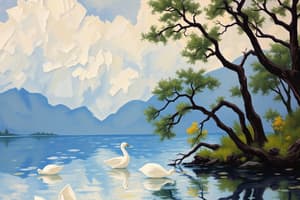Podcast
Questions and Answers
What do living things need to survive?
What do living things need to survive?
- Food and water (correct)
- Sunlight and air
- Shelter and protection
- None of the above
Living things cannot grow.
Living things cannot grow.
False (B)
What is the term used to describe the time from birth to death?
What is the term used to describe the time from birth to death?
Life
Non-living things do not need __________ or water.
Non-living things do not need __________ or water.
Match the following stages of the life cycle with their descriptions:
Match the following stages of the life cycle with their descriptions:
Which phrase is used to indicate something that is close?
Which phrase is used to indicate something that is close?
The present continuous tense is formed using 'Am', 'Is', 'Are' followed by the base form of the verb.
The present continuous tense is formed using 'Am', 'Is', 'Are' followed by the base form of the verb.
What do you call the action of giving food to animals on a farm?
What do you call the action of giving food to animals on a farm?
In agriculture, farmers often _____ fruits from the trees.
In agriculture, farmers often _____ fruits from the trees.
Match the activities with their corresponding actions on the farm:
Match the activities with their corresponding actions on the farm:
Flashcards are hidden until you start studying
Study Notes
Vocabulary and Sentence Construction
- Emphasis on using “there is” and “there are” for object location.
- Encourages making sentences and sharing for practice.
Identification and Proximity
- Activities involve identifying personal pronouns ("I") and animals in relation to the speaker.
- “Here” indicates proximity; “there” indicates distance in context.
Farm Activities
- Key farm actions include feeding animals, driving tractors, picking fruits, and planting seeds.
- Each action aligns with specific verbs: feed, carry, pick, drive, plant.
Living vs. Non-Living Things
- Living things include animals and plants; require food and water, grow, and reproduce.
- Non-living things do not require sustenance and cannot grow.
Life Cycle Concept
- Life defined as the span from birth to death.
- Cycle denotes repeated processes; example: seed growth into a plant.
- Visual diagrams clarify the growth process and life cycle stages.
Plant Growth Analysis
- Questions prompt observation of plants' positioning relative to the ground.
- Singular and plural forms reinforced with “it” for singular and “they” for plural.
Planting Process
- Steps include: planting seeds, seed germination, growth into larger plants, and bearing fruits.
Storytelling and Folktales
- Folktales illustrate cultural stories that are retold without original documentation.
- Key elements include identifying main characters, story type (real vs. make-believe), and prediction based on title and images.
Text and Context
- Importance of understanding vocabulary through context; involves scanning for main ideas.
- Retelling stories using multimedia tools reinforces comprehension.
Collaborative Learning
- Activities include creating story maps with paper strips for visual storytelling.
- Encourages discussion about teamwork and helping friends in various scenarios.
Studying That Suits You
Use AI to generate personalized quizzes and flashcards to suit your learning preferences.




